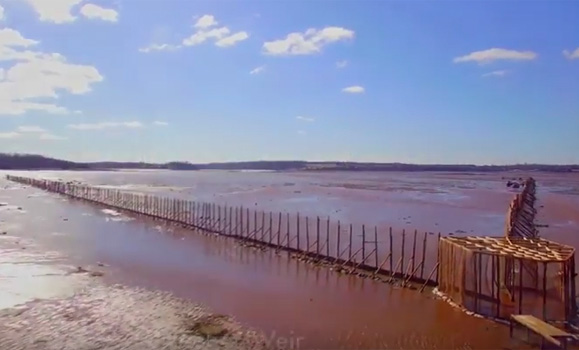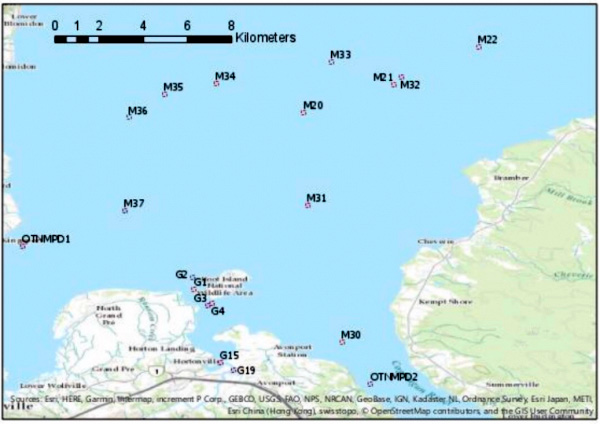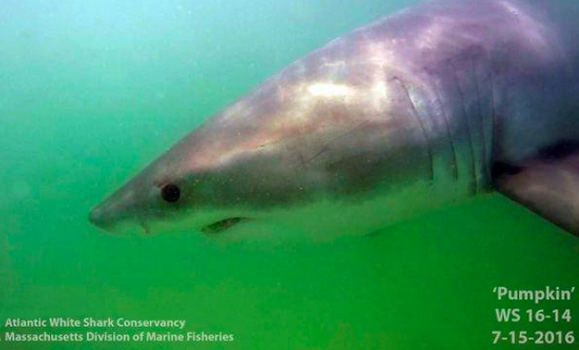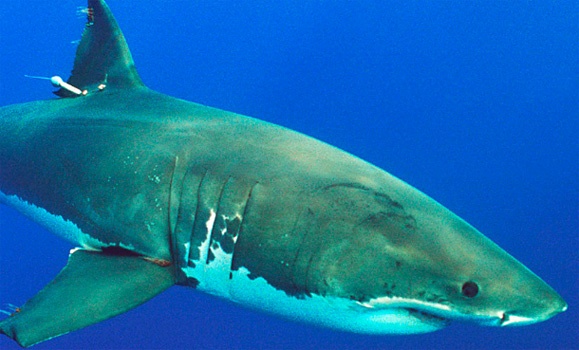When Darren Porter obtained his commercial weir license eight years ago and set up shop in Bramber, Nova Scotia, he never thought he’d be at the centre of an international shark-tracking effort.
The Dalhousie-based Ocean Tracking Network (OTN) has been linking up the Bay of Fundy and surrounding inland waters with monitoring devices to track commercially and ecologically valuable marine species. Porter’s weir is a perfect monitoring spot to help capture the migrations of fishes like American shad, skates, and striped bass, tracking them as they travel throughout the Basin and beyond.
As the tides in the Bay of Fundy ebb in and out from the shoreline, a V-shaped net traps fish and other marine animals and allows fishers to harvest only what they need.

Darren Porter’s commercial fishing weir in Bramber, Nova Scotia, is built and torn down each year from March to April during low tide.
“We have different ponds set up to hold things in that we don’t commercially use, when the tide comes back in, it just lifts to fish up and they move away. I harvest only a little piece of each tide.”
For the last two years, Porter has looked after a key acoustic telemetry monitoring infrastructure in the Minas Basin. He works with OTN researchers at Acadia University studying sturgeon in particular – a critically endangered species, and the source of precious and expensive caviar. Tidal turbine developments scheduled for Fundy region may impact sturgeons’ movements and survival. But lately, Porter’s focused on another animal moving through his waters, (though not in his weir): white sharks.
Tracking Anadale
Andale is a white shark acoustically tagged by Greg Skomal and John Chisholm at the Massachusetts Shark Research Program (MSRP) in 2012. She has been documented going back and forth between southern Atlantic U.S. and Canada, including Nova Scotia’s southwestern shores into the Bay of Fundy, for six years.
 She was detected just off Cape Split, Nova Scotia, a popular hiking area and home to seal hangouts.
She was detected just off Cape Split, Nova Scotia, a popular hiking area and home to seal hangouts.
(Image right: Acoustic receiver monitoring coverage in the Minas Passage/Bay of Fundy.)
While the appearance of white sharks on North America’s east coast has caused a stir among beach-goers, both fishers and scientists maintain that the animals have always moved through these waters.
“Its all about basic needs,” says Fred Whoriskey, executive director of OTN. “The Atlantic region, including Cape Cod up to Newfoundland, has seal colonies – sharks are just following the food.”
The power of collaboration
For the last few years, Porter’s found himself in a unique position as a citizen scientist. Not only does he help maintain the existing OTN monitoring system, he’s added to it by buying and deploying his own gear (funded through Big Moon Power) to track species important to his own livelihood.
 “I can access places cheaper, faster and more efficiently than anybody else because I already have the gear and my life already revolves around nature,” he says.
“I can access places cheaper, faster and more efficiently than anybody else because I already have the gear and my life already revolves around nature,” he says.
Porter regularly checks in with OTN and MSRP on white shark detections in the area. He hopes the public perception of sharks will change and marine animals can be seen as more than just resources. “We have to have more outreach, we must educate the public on what’s here.”
He also strongly advocates for the integration of local and traditional (First Nations) knowledge when it comes to designing research studies. “You need a basic understanding prior to the commencement of any scientific operation,” explains Porter. “We fish 14 tides a week for 299 tides straight; every single fish counted measured and recorded. That’s never been done before and that’s what we need: fishermen, Indigenous knowledge and traditional uses.”
Research through partnership
Last year, the OTN Minas Basin receivers picked up Pumpkin, another white shark tagged by the Massachusetts team. The news generated significant buzz for being one of the earliest white shark detections in this area ever recorded and, fittingly, was detected near Windsor, Nova Scotia — known as the pumpkin capital of the world.

Pumpkin, an acoustically tagged white shark, made an appearance last year in Minas Basin, Nova Scotia.
“I’ve seen sharks out my backdoor for many years but not everyone believed me. Now she’s ‘real’ because she’s been detected with acoustic receivers. Pumpkin was a great way to bring people closer to the value of local knowledge holders.” Pumpkin was detected in Cape Cod on July 17.
Andale will be monitored by roughly 80 receivers in the Minas Passage while she’s here and is expected to move off when waters begin to get colder in late summer/early fall, or when food becomes scarce. Porter continues to offload receivers in Minas Passage weekly, sometimes daily, and connects with OTN and MSRP scientists adding significant capacity to the research.
“This is a story of partnership, transparency and technology: you have the U.S. and Canada working together, fishermen working with scientists, and different technologies and uses coming together,” says Porter. “If you can partner with all the stakeholders, you bring us all to the table, you take the skill sets of everyone involved, we can achieve second-to-none science.”
Porter’s fishing weir was recently the subject of a short film documenting such partnerships. View the short here.

